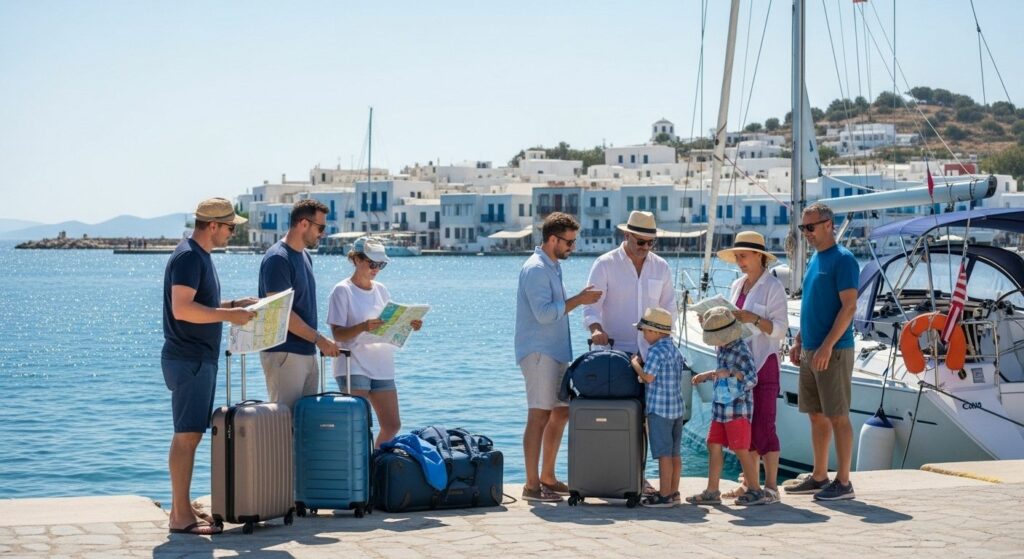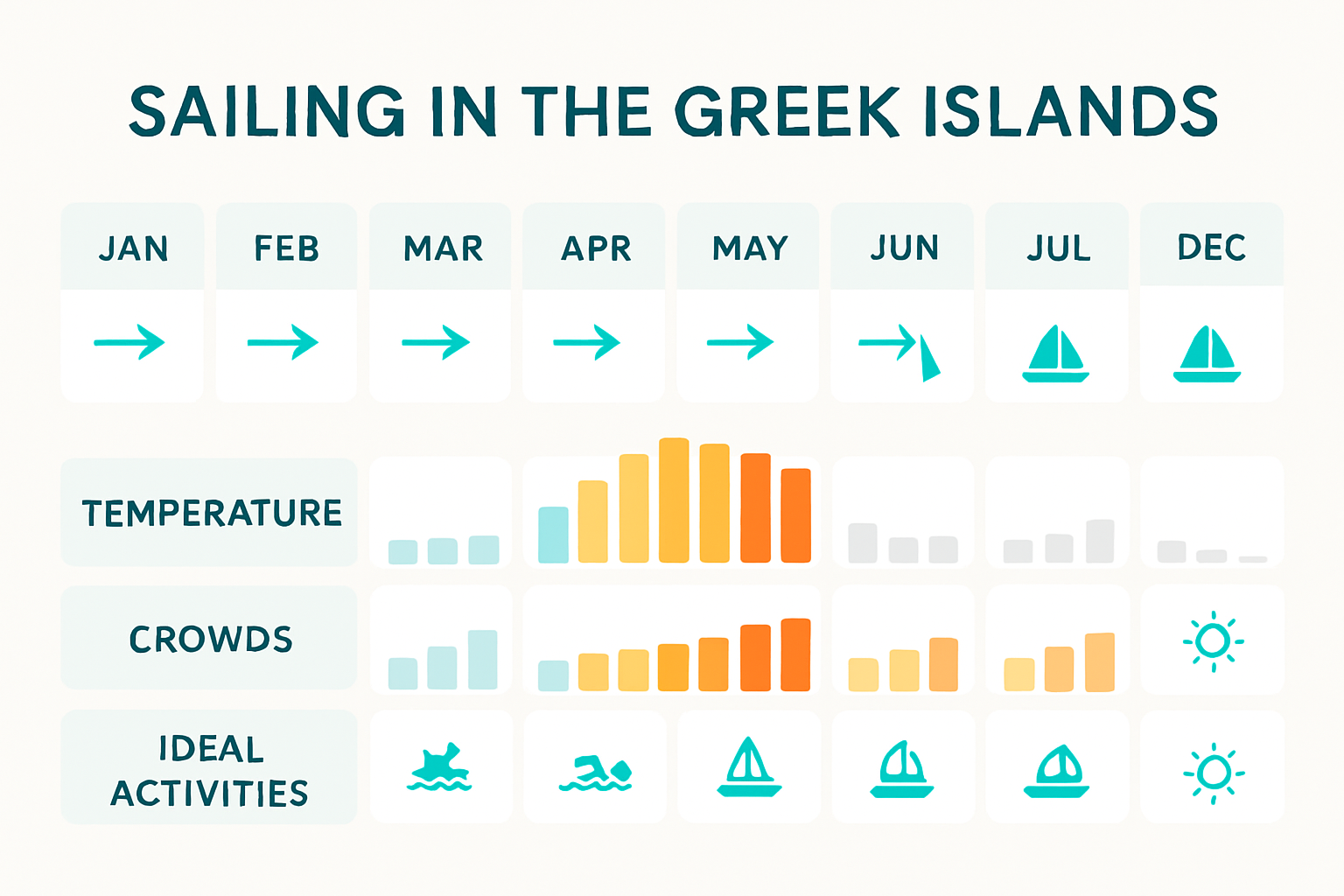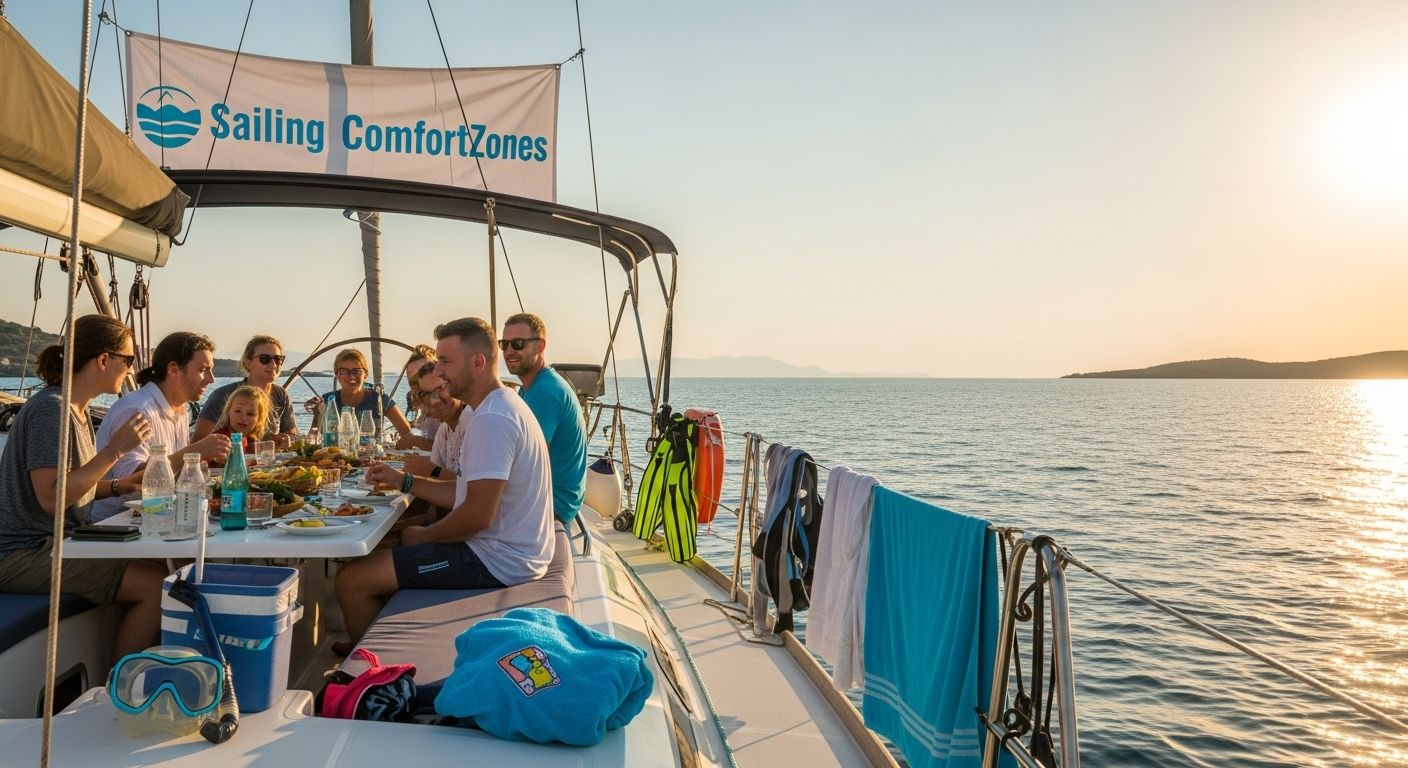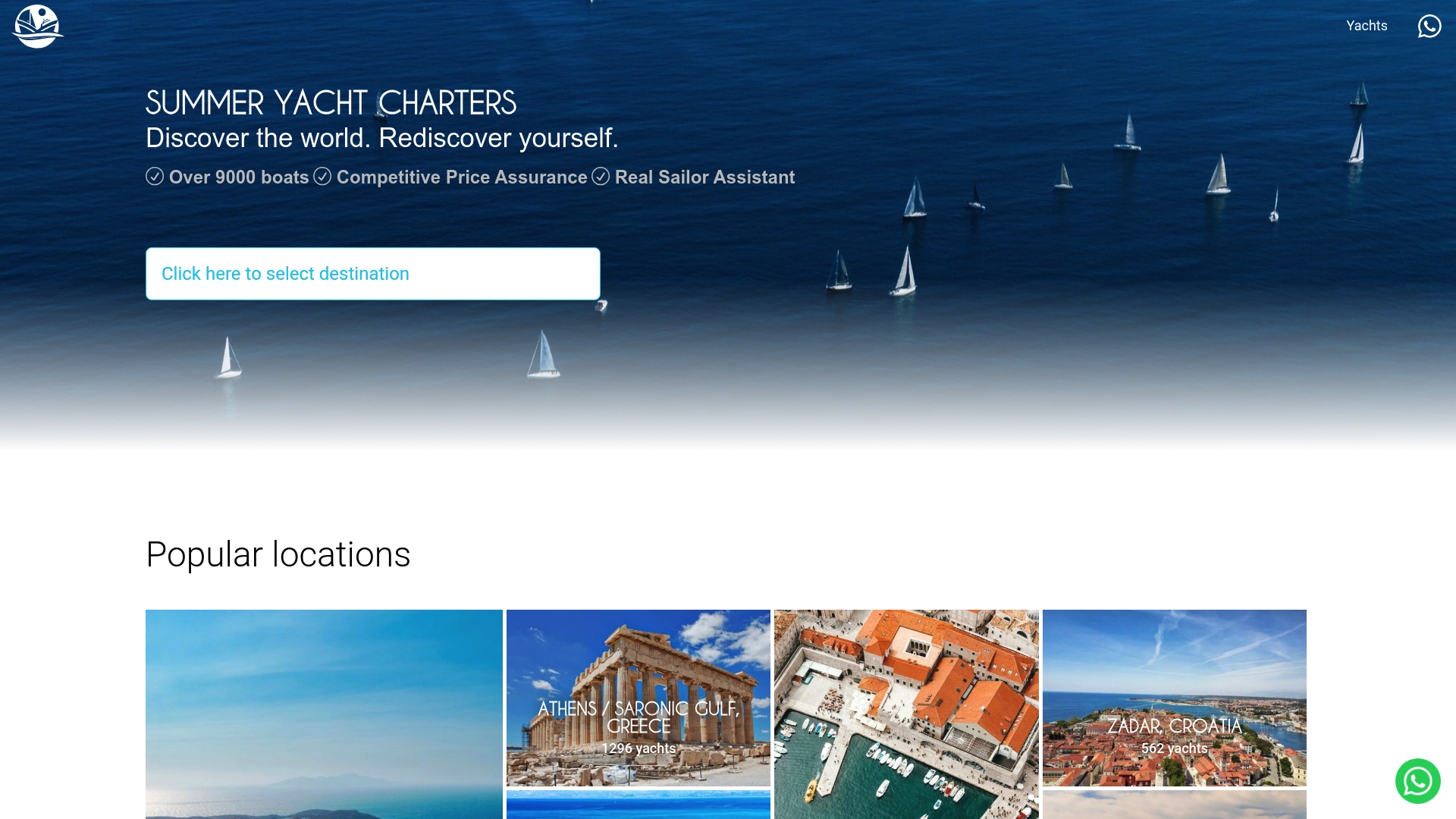Best Time to Visit Greek Islands for Sailing and Adventure
Discover the best time to visit Greek Islands for sailing, relaxation, and adventure. Make the most of your holiday with expert tips and seasonal insights.

Sailing the Greek Islands tempts with its turquoise waters, sunlit coastlines and legendary hospitality. Most think July and August are unbeatable for adventure, but that is not the full story. Shoulder seasons like May or September can mean milder temperatures, empty bays and costs up to 30 percent lower than peak summer. Those quieter months often turn a simple getaway into the perfect blend of comfort, culture and open-sea freedom.
Table of Contents
- Seasonal Weather And Sailing Conditions Explained
- Best Months For Different Traveller Types
- Events, Festivals, And Local Highlights
- Insider Tips For Planning Your Island Trip
Quick Summary
| Takeaway | Explanation |
|---|---|
| Optimal sailing months vary by adventurer type | Late May to early July suits performance sailors; leisure travellers prefer late April to early June and September to October. |
| Shoulder seasons offer fewer crowds and better conditions | Late spring and early autumn provide milder temperatures and serene sailing experiences, ideal for families and leisure seekers. |
| Understand wind patterns for safe navigation | Familiarity with Meltemi winds in summer months is crucial for safe sailing, especially for advanced sailors. |
| Align trips with local festivals for cultural immersion | Timing visits with island events, like harvest festivals, enhances the sailing experience and provides deeper cultural connections. |
| Thorough preparation is key for a successful trip | Establishing proper documentation and strategic route-planning ensures a smooth, enjoyable adventure through the Greek Islands. |
Seasonal Weather and Sailing Conditions Explained
Understanding the seasonal patterns of the Greek Islands is crucial for planning an extraordinary sailing adventure. The Mediterranean climate offers distinct sailing conditions that vary dramatically throughout the year, presenting unique opportunities and challenges for maritime enthusiasts.

Mediterranean Wind Patterns and Sailing Dynamics
The Greek sailing landscape is dramatically shaped by its renowned wind systems, particularly the famous Meltemi winds. According to the World Bank Climate Knowledge Portal, these seasonal winds typically emerge in July and August, creating challenging yet exhilarating sailing conditions. The Meltemi winds, blowing from the north-northeast direction, can reach strengths between 4-7 beaufort, which translates to wind speeds of 11-38 kilometres per hour.
Experienced sailors often view these winds as both a challenge and an opportunity. While they can make navigation more demanding, they also provide excellent conditions for advanced sailing techniques and high-performance yacht handling. The wind patterns are most consistent in the Cyclades and Dodecanese island groups, where sailors can expect predictable yet powerful maritime conditions.
Temperature and Sailing Comfort Zones
Sea and air temperatures play a critical role in determining the ideal sailing periods. During late spring (May to early June) and early autumn (September to October), temperatures range comfortably between 20-28 degrees Celsius, creating optimal conditions for sailing adventures. These shoulder seasons offer several advantages: milder temperatures, fewer tourists, and more relaxed maritime environments.

Summer months, particularly July and August, experience peak temperatures often exceeding 30 degrees Celsius. While these periods offer guaranteed sunshine, they also present potential challenges such as intense heat, crowded marinas, and higher charter rates. Sailors seeking more tranquil experiences might prefer the shoulder seasons when the maritime environment is less congested.
Navigational Considerations and Safety
Weather predictability is paramount for safe sailing. Sailors should always consult local maritime forecasts and invest in reliable weather monitoring tools. Research indicates that understanding local wind patterns, potential storm systems, and sea conditions is crucial for safe navigation.
Interested sailors can enhance their trip planning by exploring our comprehensive route planning guide to understand how seasonal variations impact maritime navigation. Preparation, local knowledge, and adaptable sailing skills are key to transforming potential weather challenges into memorable maritime experiences.
Whether you are an experienced skipper or an adventurous novice, understanding these seasonal nuances will significantly enhance your Greek Islands sailing expedition. Each season offers a unique perspective of this stunning maritime landscape, promising unforgettable adventures for those willing to adapt and embrace the dynamic Mediterranean sailing environment.
Best Months for Different Traveller Types
The Greek Islands offer diverse sailing experiences that cater to various traveller types, with each month presenting unique opportunities and challenges. Understanding these nuances can help sailors select the perfect time for their maritime adventure.
Adventure Seekers and Performance Sailors
According to Nautilius Yachting, adventure enthusiasts will find their sweet spot between late May and early July. During this period, wind conditions are optimal for high-performance sailing, particularly in the Cyclades and Dodecanese regions. The Meltemi winds provide consistent breeze strengths between 4-6 beaufort, perfect for experienced sailors looking to test their skills.
Sailors seeking challenging maritime conditions should target July and August, when wind speeds are most predictable and intense. These months demand advanced sailing techniques and provide an exhilarating experience for those who thrive on maritime challenges. Research from Sunsail confirms that experienced sailors often prefer these peak summer months for their dynamic sailing environments.
Leisure Travelers and Family Groups
For those prioritizing comfort and relaxed sailing experiences, the shoulder seasons of late April to early June and September to October emerge as ideal periods. These months offer several compelling advantages: moderate temperatures ranging between 20-28 degrees Celsius, fewer crowds, and more tranquil maritime environments.
Family groups and leisure travelers will appreciate the gentler wind conditions during these periods. Sea temperatures become increasingly comfortable, averaging around 22-25 degrees Celsius, making swimming and water activities highly enjoyable. Additionally, marina costs tend to be lower, and popular destinations are less congested, allowing for more authentic and intimate island experiences.
Photography and Cultural Exploration Enthusiasts
Travellers interested in capturing stunning landscapes and experiencing local cultural festivals should consider planning their sailing adventures during specific months. May offers incredible photographic opportunities with vibrant wildflower blooms and crystal-clear waters. September presents a magical post-summer atmosphere, with softer light and more relaxed island communities.
Cultural events like local festivals, traditional maritime celebrations, and harvest seasons add unique dimensions to sailing trips. September, in particular, provides rich experiences with grape harvests, traditional music festivals, and less intense tourist traffic. Spasso Sailing Guide recommends these shoulder months for travelers seeking deeper cultural immersion.
For sailors looking to refine their trip planning, our comprehensive yacht charter guide offers additional insights into creating the perfect maritime adventure. Each traveller type will find their ideal sailing window within the Greek Islands’ dynamic and enchanting maritime landscape, promising unforgettable experiences tailored to individual preferences and skill levels.
To help travellers choose the best time for sailing in the Greek Islands according to their preferences and skill levels, the table below compares optimal months, main advantages, and relevant considerations for different traveller types.
| Traveller Type | Optimal Months | Main Advantages | Relevant Considerations |
|---|---|---|---|
| Adventure Seekers/Performance Sailors | Late May – Early July; July–August | Strong, consistent winds for advanced sailing; thrilling conditions | Demanding navigation skills required; Meltemi winds stronger |
| Leisure Travellers/Family Groups | Late April – Early June; September–October | Milder temperatures; calmer seas; fewer crowds; lower costs | Less wind for sailing excitement; ideal for relaxing |
| Photography/Cultural Enthusiasts | May; September | Vibrant landscapes; cultural festivals; soft light | Fewer major sailing events in May; lighter winds |
Events, Festivals, and Local Highlights
The Greek Islands are not just a sailing destination but a vibrant cultural landscape where maritime traditions, local celebrations, and sailing events create extraordinary experiences for visitors. Understanding the seasonal festivals and maritime highlights can transform an ordinary sailing trip into an immersive cultural journey.
Sailing Competitions and Maritime Regattas
According to the ORC International Sailing Schedule, the Ionian International Sailing Week represents a premier maritime event for competitive sailors. Scheduled from August 4 to August 11, 2025, this competition attracts sailing enthusiasts from around the world, featuring ORC Club and ORC International classes. Professional and amateur sailors alike can test their skills in challenging maritime conditions while experiencing the breathtaking Ionian seascape.
Beyond international competitions, local regattas offer unique opportunities for sailors to engage with traditional maritime culture. Many Greek islands host annual sailing events that blend competitive spirit with cultural celebration, providing participants with more than just a racing experience. These events often include social gatherings, traditional music performances, and opportunities to connect with local sailing communities.
Maritime Heritage and Cultural Exhibitions
The Greek Islands boast a rich maritime heritage that extends far beyond modern sailing competitions. The Archipelago Network’s maritime exhibitions offer sailors and cultural enthusiasts profound insights into local seafaring traditions. Events like the ‘Crafts of the Sea: Amorgos’ exhibition, held from June 14 to 22, showcase the intricate relationship between islanders and the maritime environment.
These cultural events provide unique opportunities for sailors to understand the deeper context of their maritime adventure. Exhibitions often feature photographic installations, documentary screenings, and interactive displays that highlight traditional boat-building techniques, fishing practices, and the historical significance of maritime communities. The September ‘Crafts of the Sea: Paros’ exhibition, for instance, celebrates boatbuilding and seafaring heritage across the Cycladic islands, coinciding with the annual ‘Kapetaneika’ traditional boat regatta.
Local Festivals and Island Celebrations
The sailing season coincides with numerous local festivals that offer sailors an authentic glimpse into Greek island culture. Late summer and early autumn are particularly rich with celebrations, featuring traditional music, dance performances, religious processions, and culinary festivals. Many of these events have maritime themes, reflecting the islands’ deep connection to the sea.
For travelers seeking cultural immersion, timing a sailing trip to coincide with local festivals can create unforgettable memories. Religious festivals like the Feast of the Dormition of the Virgin Mary on August 15th are celebrated across multiple islands with great enthusiasm, featuring traditional music, local cuisine, and community gatherings. These events provide sailors with opportunities to engage directly with local communities and experience the genuine hospitality of Greek island cultures.
Our comprehensive yacht charter guide can help sailors plan their trips to align with these extraordinary cultural experiences. By understanding the rich tapestry of maritime events and local celebrations, sailors can transform their journey from a simple nautical adventure into a profound cultural exploration of the Greek Islands.
Insider Tips for Planning Your Island Trip
Planning a sailing adventure through the Greek Islands requires meticulous preparation, strategic decision making, and an understanding of the unique maritime landscape. These insider tips will help sailors navigate the complexities of creating an unforgettable island-hopping experience.
Licensing, Documentation, and Nautical Credentials
Before embarking on your Greek sailing adventure, understanding maritime documentation is crucial. Experienced sailors must possess valid international sailing credentials, such as the International Certificate of Competence (ICC) or equivalent maritime qualifications. The National Outdoor Leadership School recommends sailors thoroughly review their licensing requirements at least three months before departure.
Sailors should compile a comprehensive documentation portfolio including:
For convenient trip preparation, the following checklist summarises the key documentation and credentials travellers should organise before embarking on a Greek Islands sailing adventure.
| Documentation/Credential | Required (Yes/No) | Notes/Details |
|:—————————————|::—————–:|:———————————————————|
| Valid Passport (min. 6 months validity)| Yes | For all travellers |
| International Sailing Certificate (ICC)| Yes (for skippers)| Or recognised equivalent credentials |
| Vessel Insurance Documentation | Yes | Proof of yacht insurance |
| Medical Travel Insurance (maritime) | Yes | Should include sailing activities |
| Emergency Contact Information | Yes | Necessary for safety/emergencies |
| Vessel Registration Documents | Yes | Required for chartered or owned boats |
| Schengen Visa (non-EU citizens) | Yes (if applicable)| For non-EU citizens only |
- Valid passport with at least six months remaining
- Internationally recognized sailing license
- Vessel insurance documentation
- Medical travel insurance with maritime coverage
- Emergency contact information
- Copy of vessel registration documents
Additionally, non-EU citizens must ensure they understand Schengen visa requirements and potential maritime entry regulations. Each document plays a critical role in ensuring a smooth and legally compliant sailing experience across Greek territorial waters.
Route Planning and Island Selection Strategy
Successful Greek island sailing demands strategic route planning. According to sailing experts, sailors should consider geographical proximity, wind patterns, and individual island characteristics when designing their maritime itinerary. The Cyclades and Dodecanese archipelagos offer distinct sailing experiences, with each island group presenting unique navigational challenges and cultural opportunities.
Consider developing a flexible sailing plan that accounts for:
- Prevailing wind directions
- Distance between islands
- Available marina facilities
- Potential sheltered anchorage locations
- Local maritime traffic patterns
Experienced sailors recommend maintaining a moderate daily sailing distance of 20-40 nautical miles, allowing sufficient time for exploration, rest, and unexpected maritime conditions. Utilizing digital navigation tools and consulting local maritime charts can significantly enhance route precision and safety.
Practical Preparation and Essential Onboard Considerations
Preparing for a Greek island sailing adventure extends beyond route planning. The American College of Greece emphasizes the importance of comprehensive onboard preparation. This includes selecting appropriate sailing gear, understanding local provisioning options, and maintaining a well-equipped vessel.
Key preparation considerations include:
- Packing lightweight, quick-drying maritime clothing
- Bringing sufficient sun protection
- Carrying a comprehensive first-aid kit
- Ensuring reliable communication equipment
- Stocking adequate fresh water and non-perishable provisions
- Carrying spare parts for critical vessel systems
For sailors looking to refine their trip planning expertise, our comprehensive island-hopping guide offers additional insights into creating the perfect maritime adventure. By combining thorough preparation, strategic planning, and a spirit of adventure, sailors can transform their Greek island expedition into an extraordinary maritime experience that transcends typical vacation expectations.
Frequently Asked Questions
What is the best time for sailing in the Greek Islands?
The optimal sailing months vary by traveller type, with late May to early July being ideal for performance sailors, while leisure travellers and families should consider late April to early June and September to October for milder weather.
How do the Meltemi winds affect sailing conditions in the Greek Islands?
The Meltemi winds typically appear in July and August, providing strong and consistent breezes ideal for experienced sailors. However, they can create challenging navigation conditions that require advanced sailing techniques.
Why are shoulder seasons better for family sailing trips?
The shoulder seasons of late spring and early autumn offer milder temperatures, fewer crowds, and lower costs, making them ideal for families and leisure seekers who prefer a more relaxed sailing experience.
What documents are required for sailing in the Greek Islands?
Sailors must possess valid documents such as an international sailing certificate, vessel insurance proof, a valid passport, and, if applicable, a Schengen visa for non-EU citizens. Thorough preparation ensures compliance with maritime regulations.
Ready to Experience the Perfect Greek Island Sailing Season?
After reading about the unique weather patterns, wind conditions, and the importance of navigating the shoulder seasons, you may be wondering how to actually make your dream adventure a reality. Many sailors struggle with picking the best month, finding the ideal route, or dealing with crowded marinas. At Summer Yacht Charters, we simplify the journey. You can browse Sailing routes and hand-picked Cyclades destinations matched to your skill level and favourite time to sail.

Let us put you in the captain’s seat with over 11,000 Mediterranean yachts, directly available for your chosen dates and needs. Start customising your Greek island adventure today at Summer Yacht Charters. Explore our tailored itineraries, unlock the best sailing months, and secure your yacht before the season fills up. Your unforgettable holiday starts with just a few clicks.
Recommended
- The Circle of Marvel – Sailing the Cyclades, Part 1 – Summer Yacht Charters
- Sailing the Aegean Sea
- Catamaran or Sailboat: Best Choice for Greece Islands – Summer Yacht Charters
- Sailing Holidays for Couples: Discover Romantic Destinations – Summer Yacht Charters
- The Best Time of Year for Cenote Diving – The Cenote Guy